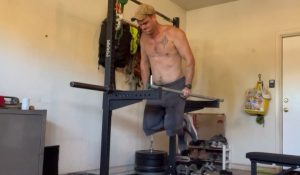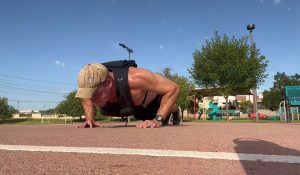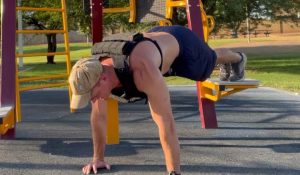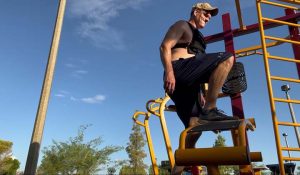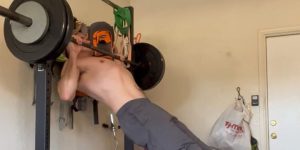There are those who swear that regular, basic bodyweight exercises can’t be applied effectively to traditional muscle-building or strength training splits. To those people, I would ask – have you ever tried it?
I’ve found that most individuals can go farther than they think with simple calisthenic exercises, provided they apply the proper principles of managing weekly volume, intensity, and recovery to their workouts.
A calisthenic push, pull, legs split is a method of distributing weekly volume by grouping exercises together by movement pattern: pushing exercises, pulling exercises, and leg exercises. Typically, this split involves lifting 6 days per week, and it can be done with calisthenic exercises provided the lifter follows the proper guidelines for intensity, weekly volume, and recovery.
What follows is a bodyweight push, pull, legs split program. Feel free to utilize the program as written or modify it to your liking or to your available equipment.
But enough talk:
The push, pull, legs calisthenics program
What follows is a program layout for a calisthenic push, pull, legs routine. Traditionally, a push, pull, legs split is broken down into 6 workouts: two workouts per week each for pulling muscles, pushing muscles, and leg muscles.
After the main workout, we’ll discuss potential modifications to the program, including how (and when) to swap exercises, how to make the program fit a 5- or 4-day schedule, and how to implement a basic periodization scheme for continued progress.
For the purposes of this program, we’ll only need a modicum of equipment:
What you will need (equipment)
- Pull-up bar
- Something to elevate your feet and hands (bench, box, or chair)
- Optional equipment: Ab wheel and weighted vest
Now, on to the program!

The base (6-day) basic calisthenics push, pull, legs split:
Monday: Push Workout A
- Wide grip-decline push-ups (chest) – 3 sets @ 2-3 RIR
- Diamond push-ups (triceps) – 3 sets @ 2-3 RIR
- Pike push-ups (shoulders) – 3 sets @ 2-3 RIR
Tuesday: Pull Workout A
- Pull-ups (lats) – 3 sets @ 2-3 RIR
- Inverted rows (traps + rear delts) – 3 sets @ 2-3 RIR
- Jackknife chin-ups (biceps + lats) – 3 sets @ 2-3 RIR
Wednesday: Leg Workout A
- Front foot elevated split squat (quads + glutes) – 3 sets @ 2-3 RIR
- Long-step reverse lunges (hamstrings + glutes) – 3 sets @ 2-3 RIR
- Hanging leg raise (anterior core) – 2 sets to 2-3 RIR
- Optional: Side planks (obliques and erectors) – 1 set @ 1 minute per side, add 10 seconds per week
Thursday: Push Workout B
- “Butt-elevated” push-ups to the clavicle (chest) – 3 sets @ 2-3 RIR
- Hands-elevated Bodyweight skullcrushers (triceps) – 3 sets @ 2-3 RIR
- Feet-elevated pike push-ups or handstand push-ups (shoulders) – 3 sets @ 2-3 RIR
Friday: Pull Workout B
- Chin-ups (biceps + lats) – 3 sets @ 2-3 RIR
- Jackknife pull-ups (lats) – 3 sets @ 2-3 RIR
- Wide-grip inverted rows (traps + rear delts) – 3 sets @ 2-3 RIR
Saturday: Leg Workout B
- Rear foot elevated split squats (quads + glutes) – 3 sets @ 2-3 RIR
- Long-step step-ups (hamstrings + glutes) – 3 sets @ 2-3 RIR
- Ab Wheel (anterior core) – 2 sets @ 2-3 RIR
- Optional: Side planks (obliques and erectors) – 1 set @ 1 minute per side, add 10 seconds per week
Notes about the program
- For all exercises, rest around 3 minutes between sets to allow for a full recovery between sets.
- Utilize a proper, full range of motion for each exercise. The number of reps you complete doesn’t matter – what matters is that we hit a certain intensity target on each set.
- Each exercise says a number of sets, then “@ 2-3 RIR”. RIR (reps in reserve) means the number of reps you could have done before failure. A good rule of thumb for this is that your first “slow” rep tends to be around 2 reps in reserve.
- Another way of saying this would be: continue performing reps with proper form until your reps begin to slow down significantly, then stop.

Periodization and progression
You are welcome to do the program as written above indefinitely. You will definitely see progress over time.
However, in order to keep making progress on this program long-term, I recommend a progressive approach using weekly volume (number of sets completed per week) as the driver of progression.
What this looks like in practice:
Add one set per week to each exercise in the program, This should take you 3 weeks.
- Week 1: 3 sets per exercise (as written above)
- Week 2: 4 sets per exercise
- Week 3: 5 sets per exercise
- Week 4: 1 set per exercise, followed by 1 all-out set (@ 0 RIR) per exercise (low-stress week)
- Week 5 and beyond: Re-evaluate exercise selection / loads used, and start over
Once you hit a point where you feel that simple bodyweight exercises aren’t providing the stimulus you want, it’s simple and cheap to add resistance using an adjustable dumbbell or weight vest. I particularly find that using the weighted vest for squats is useful since our leg muscles are quite a bit larger and stronger than their upper-body counterparts.
Make the program your own (potential modifications)
To emphasize a certain body part
If you desire to emphasize a certain body part, then feel free to re-order the exercises to put that body part first. Generally, the first exercise of the day will get hit hardest, when we are feeling the most fresh.
For example, if you wish to hit your triceps hard, then rearrange your pushing exercises to reflect that goal: do diamond push-ups first on Monday and skullcrushers first on Thursday. To emphasize the hamstrings over the quads, start Wednesday with long-step reverse lunges and Saturday with long-step step-ups.
Swapping exercises
You are welcome to swap out exercises if you find that a certain exercise disagrees with your body or causes pain.
For instance, some people notice that diamond push-ups produce wrist pain for them (as an example). If this is you, please don’t continue hammering away at an exercise until you’re injured. Just swap the exercise out for a close-grip push-up, a parallel bar dip, or any other exercise that emphasizes the triceps.
If you do swap exercises, make sure they serve the same purpose as the original exercise. For instance, swapping a jackknife pull-up for an EZ-bar curl makes no sense – the two exercises work completely different muscle groups.
5-Day bodyweight push, pull, legs
To make the program fit a 5-day schedule, simply decide which days you’ll be workout out, and then perform the next workout in the 6-day sequence week-to-week. In the example below, our lifter has chosen to rest on Thursday and Sunday. You could just as easily rest Saturday and Sunday if you wish:
| Week 1 | Week 2 | Week 3 |
| M: Push AT: Pull AW: Legs ATh: -F: Push BS: Pull BSu: – | M: Legs BT: Push AW: Pull ATh: -F: Legs AS: Push BSu: – | M: Pull BT: Legs BW: Push ATh: -F: Pull AS: Legs ASu: – |
One note – if you know you can reliably hit a workout five days per week, it may be worth looking into a split routine that’s designed around the five-day schedule, like a bodyweight bro split.
4-Day body weight push, pull, legs
Similarly, if you desire to lift on a 4-day schedule, you could utilize the same concept as above. This variation will fit neatly into a M/T/Th/F or a M/T/Th/Sa schedule as shown below:
| Week 1 | Week 2 | Week 3 |
| M: Push AT: Pull AW: -Th: Legs AF: -S: Push BSu: – | M: Pull BT: Legs BW: -Th: Push AF: -S: Pull ASu: – | M: Legs AT: Push BW: -Th: Pull BF: -S: Legs BSu: – |
Note that if you choose the 4-day variation, you are significantly dropping your frequency. If you choose this variation, I would start the program with four sets per exercise, rather than three.
Additionally, if you are set on a 4-day schedule, it may be more beneficial to try a traditional upper / lower bodyweight split. Upper / lower splits are designed around 4-day schedules, and you’ll get to avoid having to roll your workouts over week-to-week.
Can I do a 3-day calisthenics push, pull, legs split?
Though you certainly could do a 3-day variation of push, pull, legs, it’s likely not optimal for most people. Note that the current literature shows that hitting body parts 2-3 times a week is ideal. On a three-day-per-week schedule, you’d be only hitting each body part once per week.
It could be done by simply doubling the volume of the original plan – for instance, start with 6 sets per exercise, per workout, ad progress to 8 sets per exercise, per workout. However, this would lead to some very long, very grueling workouts.
If you desire to workout three days per week, I would opt for a three-day full-body heavy, light, medium calisthenic training plan, or an “upper/lower/full” split to maintain an optimal frequency of 2-3 times per week, per body part.

Notes about rest and recovery
One of the primary benefits of a push, pull, legs routine is it allows us to hit an optimal frequency for each body part (twice per week) without complicating recovery.
Every time we hit a body part, that body part then has 2-3 full days to recover before we hit it again. This means that the push, pull, legs routine is ideal for people who need to spread the volume out throughout the week.
That being said, recovery is still important. In fact, it’s the other half of the muscle-building equation.
In order to recover properly from this program (and maximize results), it’s recommended to get 7-8 full hours of sleep per night, to eat at or above calorie maintenance levels, and to consume about .8 grams of protein per pound of bodyweight.
Calisthenic push, pull, legs workouts: Simplicity and progress!
By splitting our workout routine up into pulling exercises, pressing exercises, and leg exercises, we can build muscle, optimize recovery, and enjoy quick, efficient workouts. Note that this program is not set in stone. If you’ve got other equipment like adjustable dumbbells, resistance bands, weight vests, etc, feel free to swap in your exercises of choice.
Good luck and happy lifting!













